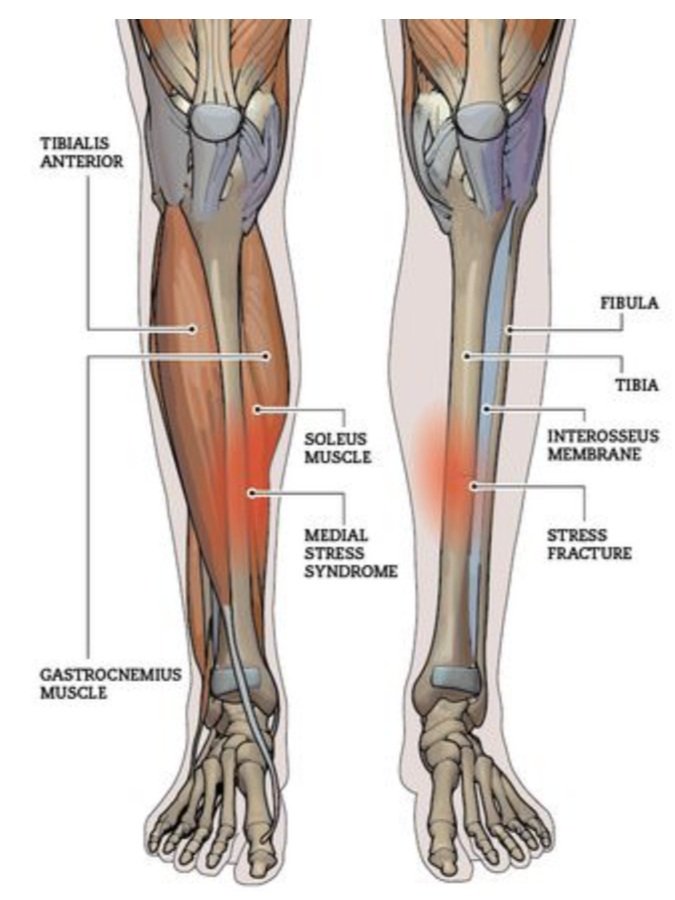3 Exercises to Address Shin Splints
Mangiarelli Rehabilitation physical therapist Sarah demonstrates three exercises you can do to address shin splint pain. Shin splints are a common athletic injury that develops due to repetitive stress placed on the tibia, causing the surrounding muscles to strain and develop microtears where they connect to the shin bone. Physical therapists can help athletes with shin splints recover pain-free movement, return to sport safely, and prevent future reinjury through a targeted exercise rehabilitation program.
How Shin Splints Develop
Shin splints are a common overuse athletic injury, often seen in runners and athletes who engage in high-impact activities like football, basketball, and soccer. Shin splints involve inflammation of the tibia and surrounding muscles and tissues caused by repetitive stress placed on the lower leg, leading to the muscles straining and developing microtears where they connect to the shin bone.
Physiologically, shin splints can result from a traction injury between the shin muscles and the shin bone, compression load on the shin bone during exercise, or muscle fatigue. The soleus muscle and the flexor digitorum longus muscles attach to the lower part of the shin bone via tibial fascia. When these muscles contract, this creates tension on the tibial fascia, causing the fascia to pull on the outer layer of the shin bone. The shin bone responds to this repetitive irritation by initiating bone remodeling, which contributes to the bumpy feeling on the shin bone during assessment and inflammation occurs where the fascia and muscles connect to the bone.
When you walk or run, the compression load on the shin bone increases. In fact, running up hill or in a zig-zag pattern can increase the compressive load 3x higher than walking. This compressive strain on the shin bone can produce shin splints. Poor running technique, such as running with stiff knees, can decrease the knee’s shock absorbing affects and lead to increased load being placed on the shin bone. The muscles of the shin and foot are supposed to act as shock absorbers as well by absorbing the stress of movement that would otherwise be transferred to the bone. If an athlete does too much activity too soon, the muscles tire, leading to a decreased ability to absorb the shock of movement and transmitting the stress to the shin bone, causing shin splints.
Common symptoms of shin splints include pain and tenderness in the lower leg and shin area, a tight Achilles’ tendon, pain during plantar flexion, and pain that increases with activity and dissipates with rest.
Shin splints often develop at the start of a sports season, when an athlete overexerts themselves or increases the frequency, duration, and intensity of their training too quickly such that the body cannot adjust to the stressor, leading to injury. Shin splints are more common in women and tend to reoccur in those that have had shin splints previously. Shin splints are also more commonly seen in runners who have fewer years of running experience or in individuals with a higher BMI, foot pronation, or external rotation of the hip’s range of motion during running. Running on uneven, hard surfaces can also contribute to the development of shin splints as can improper running technique, insufficient conditioning in the athlete, or inappropriate footwear for running.
Addressing Shin Splints with Targeted Exercise
Physical therapists can help athletes with shin splints recover pain-free movement, return to sport safely, and prevent future reinjury through a targeted rehabilitation program. When shin splint pain begins, it’s important that the athlete rest from the aggravating activity, using ice, elevation, and compression to manage pain and allow for inflammation to subside. From there, the physical therapist can perform an initial evaluation and design a targeted progressive exercise program for the athlete for a safe, gradual recovery.
Physical therapy treatment for shin splints can include:
Use of ice and manual therapy to reduce pain in the shin area
Cross training, engaging in low-impact aerobic activities like aquatic therapy or stationary cycling to maintain fitness without placing additional stress on the shin
Strengthening of the calf muscles as well as improving core strength and hip, knee, ankle, and gluteal muscle strength for stability and balance throughout the kinetic chain and for proper running mechanics. Strengthening the hip and gluteal muscles is important as these muscles control the function of the knee when running. Stronger hip and gluteal muscles prevent the knee from turning in, allow for proper tibia alignment, prevent the foot arch from collapsing, and allow for improved running mechanics overall and less stress on the shin area.
Use of taping to decrease tension on the soleus and flexor digitorum muscles
Correction of biomechanical defects such as an over-pronated foot with foot orthotics
Running technique analysis and retraining to minimize stress on the shin
Modification of training regimen, allowing for a gradual increase in activity to lessen stress on the shin and shin muscles
Retraining of take-off and landing techniques for jumping athletes
Education on proper footwear and when to replace running shoes
Mangiarelli Rehabilitation physical therapist Sarah demonstrates three exercises you can do to address shin splint pain in the video below:
